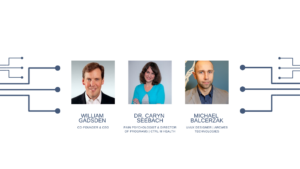In this episode, we’re joined once again by Arcweb Principal Consultant Mark Hughey and Head of Engineering Shahrukh Tarapore to discuss the Internet of Things and wearable devices. What are the cybersecurity implications? What risks ensue at adoption? We’ll discuss the pros, cons, and how companies can decide whether or not to utilize the technology.



Kurt Schiller [00:00:01]: Welcome to Product Hacker, the Arcweb Business Innovation podcast. We bring you the latest from the world of business innovation, from emerging technologies to game-changing ideas. Product Hacker connects you with the people and concepts that are changing the face of business. I’m your host, Arcweb Head of marketing, Kurt Schiller. Product Hacker is brought to you by Arcweb Technologies. Digital strategy, user experience and software engineering; that’s how we move business forward. Learn more at Arcwebtech.com.
Kurt Schiller [00:00:30]: Thanks for joining us as we continue our three-part discussion of the emerging technologies that you should pay attention to in 2018. This time we’ll be talking about wearable devices and the Internet of Things. Make sure you check out our previous episode for our take on blockchain technology.
Kurt Schiller [00:00:51]: Networked wearable devices like Fitbit and the Apple Watch are a big hit with consumers, but the technology isn’t limited to things you wear. Everything is becoming networked from your pacemaker to home security systems to your fridge. But there are concerns, including privacy, security and the ethics of gathering the data. Once again, here’s Arcweb, Head of Engineering Shahrukh Tarapore and Project Manager Mark Hughey. So, Shahrukh, is the Internet of Things worth all the trouble?
Shahrukh Tarapore [00:01:22]: Yeah, I mean, it is definitely worth all the trouble. We’ve already seen the Internet of Things enable access to markets that, you know, individuals and businesses didn’t have access to before. It’s opened up a wealth of data that can then become information that then becomes knowledge that businesses can use to provide greater value in services to the users they are trying to serve. And so the verdicts already in that there is a tremendous amount of value here. It’s more of a question of how these technologies get deployed so that they are useful in our lives and don’t consume our lives.
Shahrukh Tarapore [00:02:01]: They’re ethically appropriate that the actors in the environment have good intentions and that people can trust that data that is being recorded all around them is going to be used for reasonable purposes and that people have control over their data and kind of what it gets used for and can be the judge of how and when it should be used.
Kurt Schiller [00:02:22]: Could you talk a little bit more about the ethical and privacy concerns? So what– what would you say is the nightmare scenario? What’s the thing that we want to avoid happening?
Shahrukh Tarapore [00:02:30]: I think the nightmare scenario in my mind is that, you know, there’s this super old arcade movie called Gattaca where like, you know, it’s just like a tech-inspired universe where knowledge about every single aspect of your life and what you do and when you do it and why you’re doing it is kind of known by the authority state. It’s a deep concern for a lot of people, you know, whether, you know, wherever you reside on the political or social spectrum.
Shahrukh Tarapore [00:02:51]: You know, I think that in general, people want to live in the safety of knowing that they can kind of control their data footprint, what they’re putting out there into the world. And then who has the ability to consume it and what their intentions for consuming it is. So there’s a very vocal minority out there that believes that it’s a slippery slope and that there shouldn’t be any move in that direction. And there’s probably a more– a larger majority who believes that there are steps that can be made in that direction with the proper safeguards in place. And so it’s about finding those safeguards that are ethically and socially reasonable for society at large to take on.
Mark Hughey [00:03:31]: You know, I think there’s a really interesting aspect to what you’re talking about. And I think one of the things that maybe one of the risks or maybe one of the reasons why privacy and ethical concerns are kind of at the forefront of this discussion is that the technology has become so cheap, so quickly that it’s almost like the ability to innovate in this space is quicker than society or us, as consumers have been able to figure out how we want to interact with it.
Mark Hughey [00:04:06]: I’ve been reading things about, you know, like the chips for some of these things are becoming so cheap that, you know, a manufacturing decision to make any device, you know, your dishwasher or whatever a smart device is going to you know, it’s going to be pennies to make that manufacturing decision. You know, there’s this a question about there will be an ability for manufacturers to introduce network technology into devices where they use case isn’t really all that valuable to the consumer. And that maybe even the manufacturer hasn’t figured out how to make use of the data yet. But the barrier to introducing that technology to products is going to continue to fall as it gets cheaper.
Shahrukh Tarapore [00:04:49]: I think we’ve always had, like, you know, if I go back to the wheel or to the steam engine or to the Internet, right, as disruptive technologies, we’ve always been in a situation where society is catching up to the implications that that technology has. But I agree with you. I think that the pace at which technology is advancing and the spectrum with which that technology can use for such a broad range of applications and then also marry that with kind of a new trend that’s occurring that we didn’t have with the steam engine or with a wheel or even with the Internet, is that the barrier to be a facilitator of that technology has dropped significantly.
Shahrukh Tarapore [00:05:31]: What it takes to learn a programing language or what it takes to buy a drone and assemble that drone and then use it. That barrier has dropped significantly and more mainstream, non-classically trained technologists are popping up everywhere. And that’s a good thing. But there’s a side effect that means that the rate at which we innovate with these technologies is going to even further accelerate past society’s ability to question it and adapt to it and grow. So it’s kind of interesting world we’re living in now.
Mark Hughey [00:06:04]: I think one of the considerations, you know, for anybody out there that’s thinking about it, like how do we use this technology? How do we apply this to our space? How do we innovate here along the lines of these ethical concerns? I think one of the big considerations is where is the value to the end-user? So one of the things we do at Arcweb a lot is consult with our clients about how to provide value and provide value to the end-users. So a lot of the products that we build for them to be successful, there’s got to be adoption, right. The user has gotta want to use it. And so, when you ask yourself what problem are we solving? You know, if you’re a vendor, if you’re an organization that wants to build a digital product, are you solving a problem for yourself or are you solving a problem for the end-user of that product?
Mark Hughey [00:06:57]: Because if you’re– if you’re only doing the first and not doing the second, then that products, you know, carries a lot of risk of failure along with it. I think in this case, you know, where we’re talking about how it’s so easy and cheap for manufacturers to introduce this type of technology into their products. But if they’re not also simultaneously solving a problem and simply collecting data on their customers that’s very useful to them, that’s an ethical question, right? Is that the is that the right way to do it? Is there a way for us to collect data that helps us solve– solve user’s problems better and not simply sell them more things? I think that’s sort of a really interesting ethical and moral dilemma that needs to be explored in this space.
Shahrukh Tarapore [00:07:42]: Yeah. And you know, I think because we’re talking about like the business innovation here, right? Like, you know, there’s the ethical questions that I think businesses need to be able to solve for or at least have reasonable answers to for their users. But then there’s also an aspect of like liability too, right? So, we’re just now trying to think about what it means to think about the life– the lifecycle of a piece of data. And, you know, our ability to create data as people who use IoT devices and consume technology and interact with it to go about our lives, we’re creating tremendous amounts of data. And really IoT is kind of the– is where that data gets ingested from. But it’s really just the beginning of that lifecycle, of that piece of data. And so, you know, the liability part comes in is because once you’ve consumed that data as a business, it becomes your responsibility to maintain that data, use it, effectively, secure it, make it accessible when appropriate, make it not accessible when it’s not appropriate.
Shahrukh Tarapore [00:08:48]: Users are going to expect that you were good stewards of that data however it was collected. And in particular, in a world where IoT is making technology more ubiquitous in our environment and it’s very subtle when data is being collected about us, it’s paramount that companies have a plan for how they are managing their data. And so the ethical considerations aside, just protecting businesses and making sure that they are appropriately managing their data and how it’s deployed is vital. And something I kind of– it may sound contrary, but I tell a lot of our clients don’t collect data for the sake of collecting data.
Shahrukh Tarapore [00:09:33]: You know, we’re kind of in this trend right now, business trend right now, where “If I can collect the data, I’ll collect it”. There’s something wrong with that because– or I think there’s something wrong with that, because, you know, if we collect the data and just store it on a disk and never use it, well, there was the effort in collecting it and that may be inefficient for the business, but it also creates a liability that we’re possibly not thinking about. So I think that before we start collecting data, there should be a purpose for it. There should be a user value assigned to it. There should be– the business should have a plan for how that data is going to enrich the product or the service that they’re putting out there and then start collecting it. And then there becomes a reason for taking on all the rights and responsibilities that come with having the data at their disposal.
Kurt Schiller [00:10:21]: So we talk a little bit about the risks involved with developing IoT devices and as consumers using them. But in our– in some of our earlier conversation, we talked a little bit about the security risks of having IoT devices inside of your organization. And specifically, I think the term “instant owning” was used. Can one of you shed some light on that?
Mark Hughey [00:10:44]: Well, I mean, I think that was probably in relation to, you know, security concerns around the weakness of default security settings that come on these devices. These are– this is sort of like an example of a user experience. It wasn’t particularly well thought out. But the problem with network devices is that once they get on the network, they are then visible and accessible by potential malicious attackers. And, you know, with the you know, we’ve seen these instances, you know, big security breaches where as soon as something comes on the network, it’s being immediately attacked. And if the default credentials are in place, that device can be taken over. You know, the ownership is then transferred. The device is not usable on the network and control has been lost.
Mark Hughey [00:11:33]: There’s definitely a big concern here. And then we’re seeing in response to that, you know, there’s these groups of self-described white hat type hackers who believe that, you know, they’re it’s their obligation or their moral obligation to save the world from a network or an army of maliciously controlled devices that could bring down networks, you know, cause major denial of service attacks. You know, in various industries. And so they are trying to get ahead of the malicious attackers taking over the device by getting into the device first and bricking it, essentially, making it non-useable for its intended purpose. And all those things are big challenges.
Mark Hughey [00:12:15]: But again, I think because of the speed at which we’re innovating, you know, some of these things have gotten ahead of our ability to control it.
Kurt Schiller [00:12:24]: So much, much like the mid-2000s policy that many organizations adopted banning outside flash drives. This is kind of that same thing, but supercharged by the fact that the people adding them to the network may not even realize that their network devices.
Mark Hughey [00:12:42]: Yeah, correct. You know, another byproduct of this technology becoming kind of ubiquitous and just spreading everywhere is that, as Shahrukh said, we’re not always aware that this is a “smart device” and that data is being collected and sent somewhere else. And it’s totally transparent in some cases to the end-user.
Building a digital product?
Kurt Schiller [00:13:07]: That’s the downside. What’s the argument in favor of an organization investigating IoT or wearables? So, say if you’re a healthcare provider or if you do supply chain management, what’s the opportunity there?
Shahrukh Tarapore [00:13:23]: So I think that the two big opportunities I think that come in mind are personalization and then, you know, just-in-time, anything, right? So as an example, you know, in supply chain management, right? The idea of just-in-time supply chain management in the lean manufacturing methodology. The idea being we can get the right parts to the right section of the manufacturing floor at the right moment when that part is needed in the assembly process. And there’s great efficiencies to be gained from keeping inventories low and for ensuring that there’s a continuous feedback loop of information that tells you when material is needed to keep the assembly line going. Productivity in a manufacturing setting, productivity and the rate at which product comes off the assembly line is what drives revenue for a business like that.
Shahrukh Tarapore [00:14:15]: So where IoT can be useful there is in providing more real-time information about how those systems and how those processes are running and where that material needs to be put on the shop floor to make those assembly processes, those manufacturing processes more efficient. And then if you just take that and kind of scale it up to the global supply chain, like how we move goods and services all over the world, how we have commerce transacted from a shipping container in China, making its way to the Port of Los Angeles, getting onto a truck and in L.A. to be shipped over to Boston. The ability to track those movements and the ability to intervene in what used to be a very closed off process is going to create tremendous value and opportunity for innovation, for businesses in the future.
Mark Hughey [00:15:05]: This goes back to something you said earlier about the kind of promise of this is being able to collect data in places that were formerly inaccessible. And you also think about that in terms of the time of data collection. We do a lot of work with healthcare organizations and, you know, one of the things we’re looking at currently is right now there’s a lot of data collected about your health when you go to the doctor. And typically, that is the only time that data is being collected and recorded about your health. You know, it’s something that goes into your electronic medical record that’s likely to be shared with, you know, future doctors and healthcare organizations. But what about being able to collect data on your health situation in between those visits and have that data be accessible to a medical provider or healthcare provider so that they can review what happened in between these visits? Was the diagnosis– you know what was the prescription that I gave? Is it effective? What’s happening?
Mark Hughey [00:16:08]: The other thing that it enables is, you know, through, you know, basically alerts and notifications, you know, smart notifications and things like that. You can build into these if data is being collected on a patient, especially one that has has a critical or life-threatening condition, and the healthcare provider can be alerted when something changes beyond a particular threshold in the data. Then you introduce some efficiencies on how healthcare providers spend their time. Because you have the ability to direct them to the patients that need them most at that particular time. So I think that that’s where some of the big promise is.
Shahrukh Tarapore [00:16:50]: So last question for IoT, go now or wait on it. Shahrukh?
[00:16:55]: I think you go now. You do it with intention, obviously the ethical questions. They’re security questions. A lot of kind of the traditional way we did security over the last 30 to 50 years is it’s going to have to get thrown out for IoT to work effectively. The conventional way of doing security has been a perimeter approach where basically everything the perimeter is secure and safe and you can trust it and all you do is make sure nothing bad gets in. But in a world where you’re putting devices all over the place, we don’t always know what those devices can and can’t do. The perimeter approach doesn’t work.
Shahrukh Tarapore [00:17:27]: And so coming up with new and novel ways of securing devices, knowing their intention and then making sure that the right kind of data is collected and used in the right way is going to be vital. And so those are the things that I think companies need to be addressing right now.
Kurt Schiller [00:17:42]: Mark, your take?
Mark Hughey [00:17:44]: Yeah, definitely go. One of the other things that I think is relevant to talk about, you know, one of the things we advocate here at Arcweb is when we run projects, when we develop products with our clients, we are using a combination of agile and lean, agile being born in the software development arena and lean concepts being pioneered first in the manufacturing sector. You know, we’re using a combination of those best practices to determine what’s the smallest amount of effort that we can– the smallest amount of effort that we can do right now to test a hypothesis, to be able to validate what our assumptions about whether or not this is a worthwhile investment or something. You know, is this product idea we have, is it actually useful to users? Will they use it? Will they get the benefit that we thought that they were gonna get from using it? And all of those things are things that need to be tested. You know, whenever we say go, I don’t necessarily think that those decisions are: “Okay we have to make this giant leap of faith and make a giant investment”.
Mark Hughey [00:18:55]: There are absolutely ways for us to manage that and validate assumptions and course-correct over time to make sure that our clients money is being spent wisely and that value is being created.
Kurt Schiller [00:19:11]: Thanks for listening to Product Hacker. Join us next time when we continue our discussion about emerging technologies for 2018. Next time, we’ll be discussing voice interfaces and natural language processing. Make sure you tune in. Product Hacker is brought to you by Arcweb Technologies, a digital product design and development agency in Old City, Philadelphia. We help companies innovate, pilot new ideas and get to market fast by combining product strategy, user experience, and agile software development. Learn more by visiting us at Arcwebtech.com or calling 1(800) 846-7980.
Kurt Schiller [00:19:47]: Make sure you visit Arcweb technologies at the Amplify Philly House at this year’s South by Southwest. We’ll be joining Comcast, the University of Pennsylvania and others to talk about the innovations coming out of Philadelphia. There’ll also be panels about new technologies, concerts, and giveaways aplenty. To get more information. Visit get.arcweb.co/sxsw.
Kurt Schiller [00:20:10]: Our show is produced and engineered by Martin R. Schneider and hosted by Kurt Schiller. Want to make sure you never miss an episode of Product Hacker? Make sure to subscribe to us on iTunes, Stitcher, and other fine podcasting platforms. You can also subscribe to our mailing list at get.arcweb.co/product-hacker You’ll also get notified about upcoming Arcweb events and giveaways.



